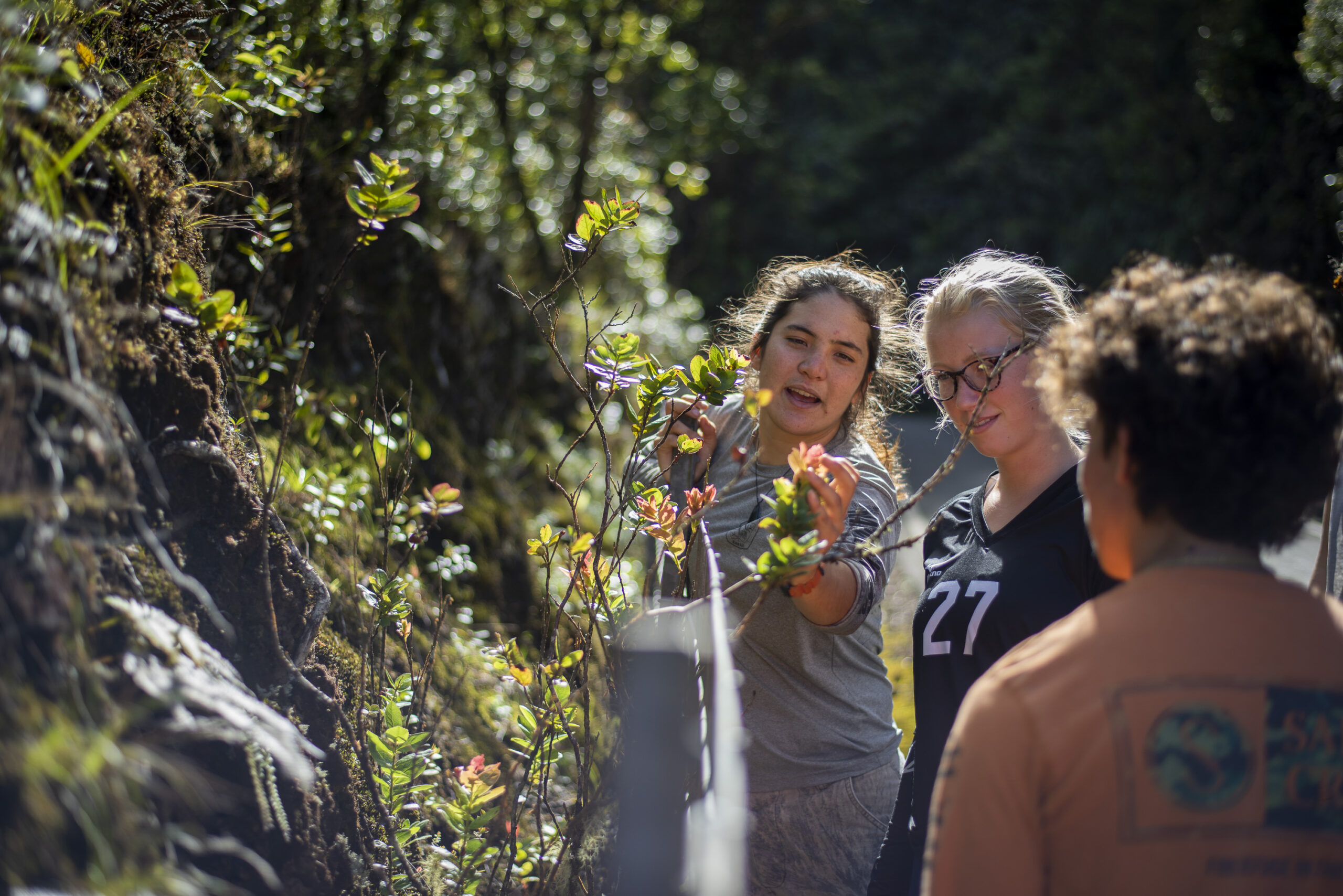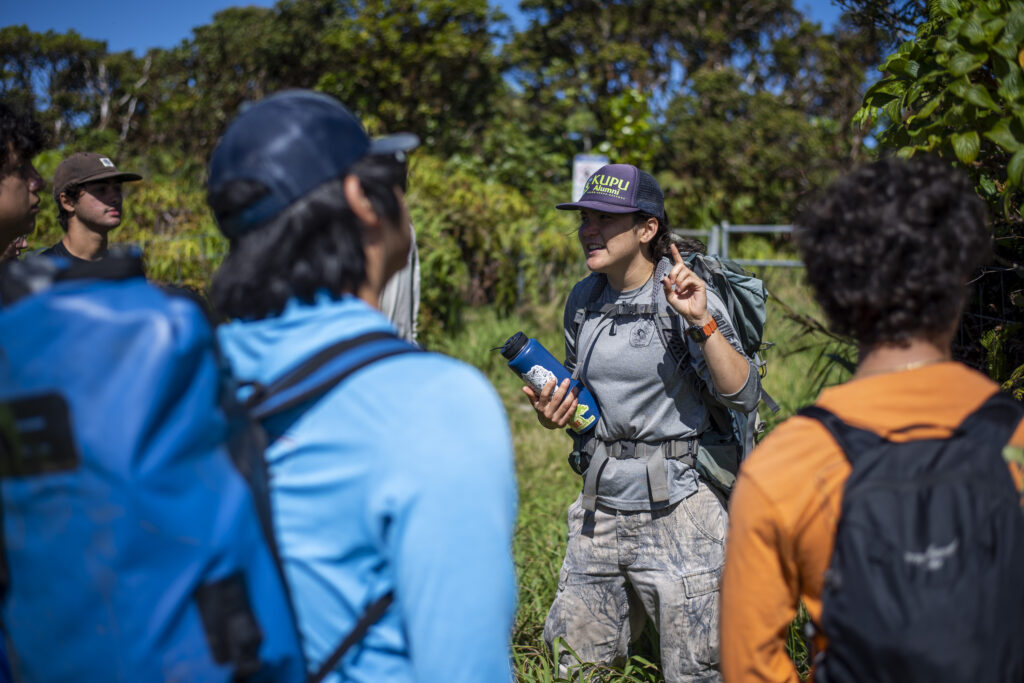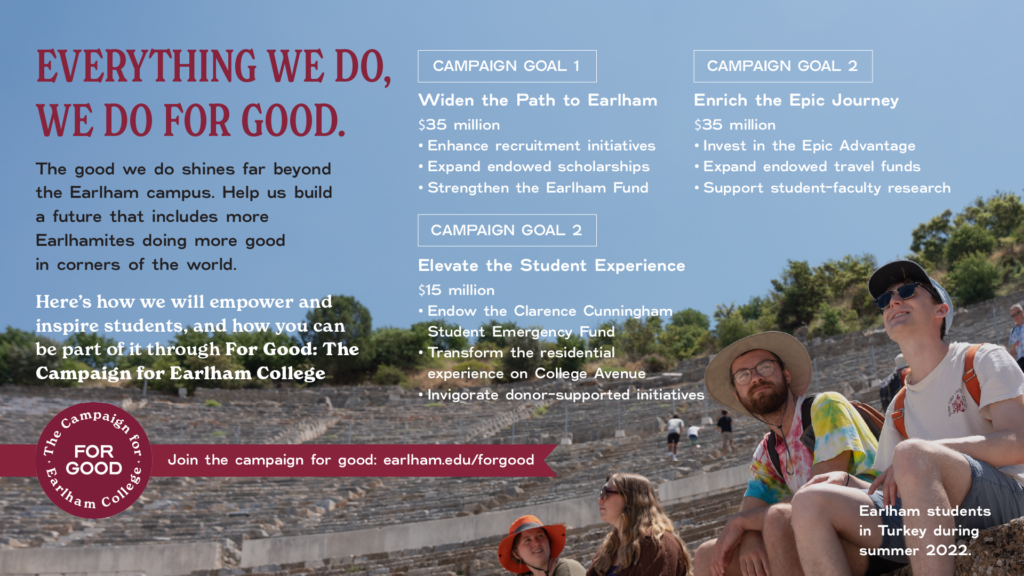
Malia Staab ’18 finds community and connection in her work with native resources and wildlife. Both have confirmed her commitment to preserving ecosystems and educating the next generation of informed stewards.
Malia Staab found her calling while lying down in a contemplative moment on a prairie in her early years at Earlham College. She was imagining that she was a seedling, growing up through the soft ground of the earth. Seedlings are the very definition of potential, of course, and that day, as Staab explored the natural world, she was also setting down roots as an activist, and as a spokesperson, teacher and advocate for Hawai‘i, the land she calls home.
The 2018 Earlham graduate arrived at college undecided about a major. She thought about psychology but then took ecological biology from plant biologist Professor Brent Smith — who led the experience that day on the prairie.
“I just thought that was so cool. No other class would have me do that,” she said. “I felt very anchored in place at that moment. I was very drawn to that type of learning, to learn with imagination and fun, and learn outside the classroom.”
Nurtured by her time at Earlham, Staab followed her dream and works as a conservation field technician for the Hawai‘i Department of Land and Natural Resources (DNLR) Division of Forestry and Wildlife, and teacher at a local high school. She lives on the island of O’ahu, and her work is “almost 100 percent fieldwork,” spending long days in the Wai’anae and Ko’olau mountains removing invasive plant species, planting native species and educating students on native ecosystems.
“We drive into the mountains and hike into the fields with chain saws, handsaws and herbicide,” she said. “The more rigorous the work the more I love it. I feel very fortunate to be able to be doing this work.”
Staab also leads volunteer groups into the mountains on special projects expanding and learning about intact ecosystems. The work is rigorous and sometimes disheartening. Has she cried removing invasive species only to know they are going to grow back? Sure. Has there been despair? Of course. But she looks to the friends around her to help her carry on. “I really get support from my blood family, a family of my Earlham friends whom I stay in contact with and really depend on, and my coworkers,” she said. “They are my communities.”
A professional journey
Each summer for the last four years Staab has traveled to Alaska where she works for the National Outdoor Leadership School (NOLS) as a backpacking and sea kayaking instructor teaching leadership, wilderness living skills and the ecology of the region. Her first year in Alaska she took a training course and worked the rest of that first summer as an instructor.
Her experience working between the two jobs has been priceless.
“I love how the environment of Alaska is so different than Hawai‘i but also similar as the glacial landscape of Alaska and the volcanic landscape of Hawai‘i are both very raw and new in terms of ecological succession,” Staab said. “They are also very rich with abundant plant and animal species.”
At Earlham, while working on a double major in biology and environmental studies with a designation in outdoor education, Staab returned to Hawai‘i to complete an intern- ship in environmental studies. She started working for the Americorps organization Kupu, which means “to sprout” or “to grow” in Hawaiian.
The organization was a perfect next step for Staab as she participated in hands-on training in conservation, sustain- ability and environmental education with young adults.
Starting stewardship early
After graduation, she returned to Hawai‘i to work for the DNLR and at Le Jardin Academy, a private K-12 school on the Windward Side (or eastern shore) of O’ahu.
“I particularly like working with students in Hawai‘i, challenging them, impressing upon them to view the land, the plants and animals as resources, to help them understand that they take care of us,” she said. Most of her work at the high school is natural resource education and student stewardship projects at the nearby Kawainui Marsh Wildlife Sanctuary.
“I particularly like working with students in Hawai‘i, challenging them, impressing upon them to view the land, the plants and animals as resources, to help them understand that they take care of us.”
Malia Staab

“So much of this love and appreciation for the land starts with education,” she said. “If you don’t learn about something, how can you understand it, appreciate it and protect it?” After a few years back home working in conservation, she enrolled in graduate school at the University of Hawai’i, earning a master’s degree in natural resource and environmental management in 2022.
The flame of her passion was lit at Earlham where Staab took advantage of every outdoor study opportunity she could find. She worked at the college’s climbing wall and on August Wilderness, a pre-orientation, field-based expedition. She went on canoeing trips to Canada and rock-climbing trips to Kentucky. She did her Earlham study abroad in New Zealand in 2016 and then led a study abroad return trip to New Zealand in 2020.
“At Earlham, that was the first time I ever camped for several days, and I had never canoed in the wilderness like that before,” she said. “For me it was simple living. It was about building friendships based on a love of being outdoors.”
Her Earlham experience helped clarify her desire to return to Hawai’i.
“The opportunity it provided me was so special,” she said. “Right before my senior year I knew that that’s what I wanted to do, to give back to the place that raised me and to do impactful work. A big inspiration for me is going and volunteering and seeing hundreds of other people volunteering, giving their time and their love. That to me is community.”
Her experience at the Le Jardin Academy stoked her related love of teaching.
“A lot of my students ask me why they should care about the environment. I tell them that if they drink fresh water, they should care about native ecosystems and healthy watersheds,” said Staab. “I believe you have a responsibility to learn about the places you live or travel to and give back. Earlham taught me to appreciate simplicity. I believe in appreciating what you have and finding good people to surround yourself with. Sharing that love with people makes me hopeful that there are enough of us out there that care about protecting wild spaces and the development of human and environmental connection.”
